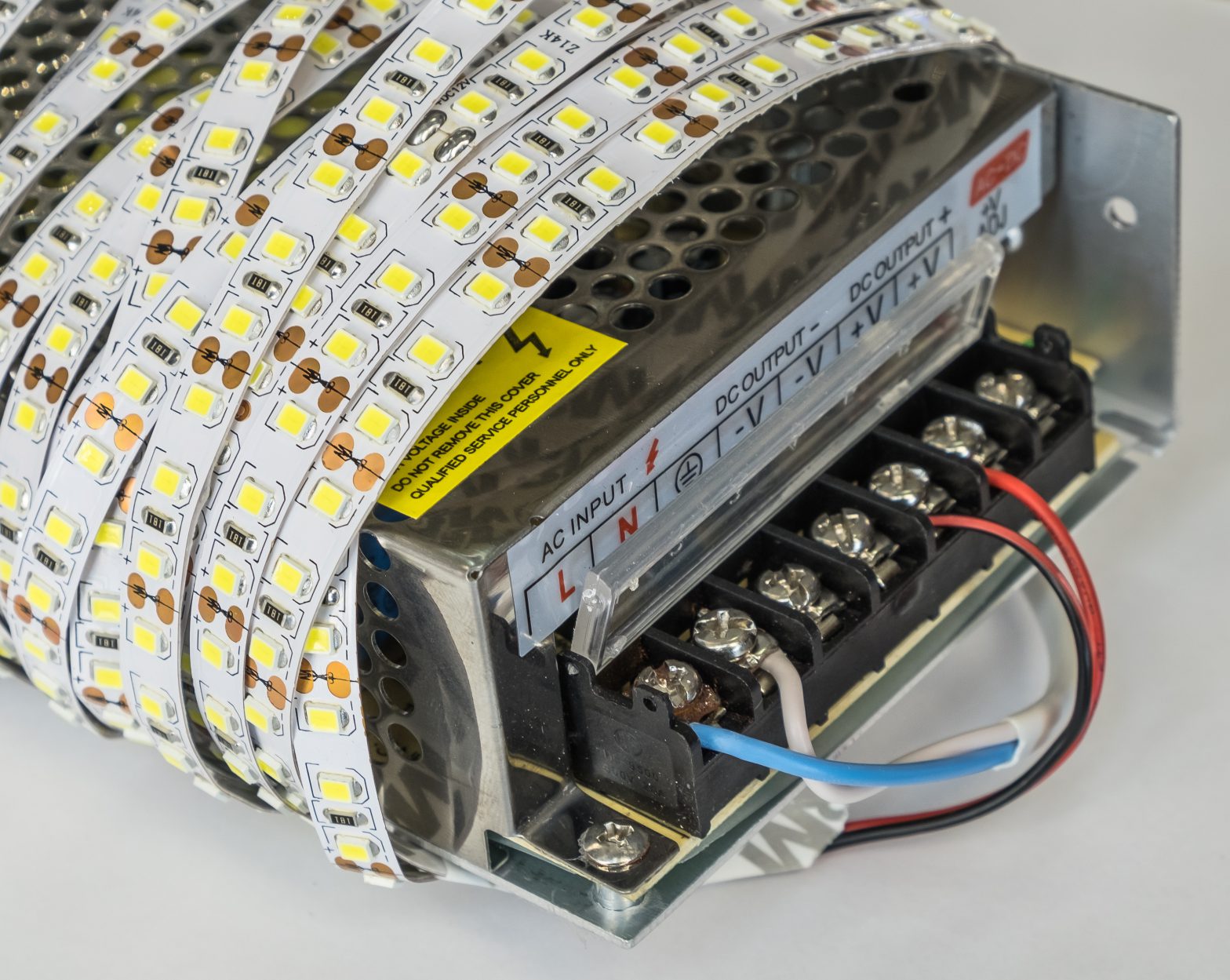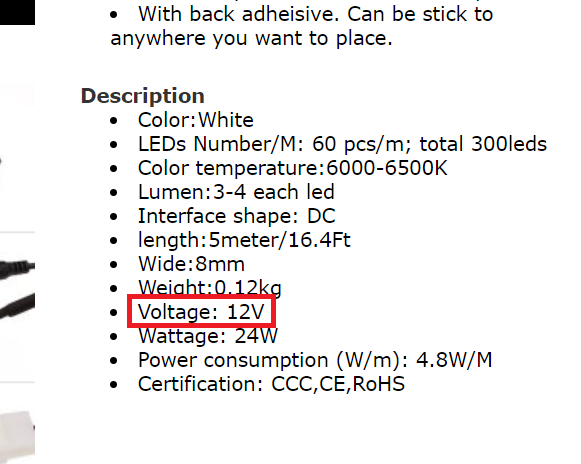
How to choose a power supply for your LED strip project
LED strips, unfortunately, are not as simple as traditional incandescent light bulbs when it comes to installation and set up. Because they run on low voltage DC, they require a power supply device that converts 120V/240V AC (depending on your location) into the voltage signal that LED strips can use. Below is our simple, no-stress, 3-step guide that will help you select a power supply.
As an example, let's suppose that you've found the following LED strip product: WenTop Waterproof Led Strip Lights SMD 3528 and want to see if this power supply will work with it.
The first step is to figure out what the voltage of the LED strip is. The majority of LED strips available on the market run at 12V DC. Others are primarily at 24V DC.
In the case of WenTop's product, we find it listed in the product description:

...as well as the specifications listed further below:

If you still aren't sure, another way to confirm this is to look at the product photo. Most LED strips will have a mark showing 12V or 24V.

Now, check if the voltage on the power supply specifications matches the LED strip. In this case, the power supply is also 12V, so we are good to go.
Also confirm that the input voltage on the AC side matches your country's voltage (120V for North America, etc).
Bonus tip: if you have a power supply lying around at home, for example, you can also check the backside label and see if the voltage is listed there.
This post contains affiliate links. If you use these links to buy something we may earn a commission.
Next, look for either a wattage (W) or amperage (A) specification for the LED strip. This could be listed as either W/m or A/m, or simply W or A.
The LED strip lists the total wattage as 24 Watts, or 4.8 Watts per meter. This checks out, because there are 5 meters per reel, and 4.8 Watts/meter * 5 meters = 24 Watts.
Although it's not listed here, we can calculate the amperage using the formula P = V x A, where P is the wattage, V is voltage and A is amperage. To solve for A (amperage), simply plug in 24 for wattage and 12 for voltage, and calculate:
24 = 12 x A
A = 2.0 Amps.
In electrical terms, we now know that at 12V, this LED strip will draw about 24 Watts per reel (5 meters), or about 2.0 Amps.
Now, let's check the power supply.
We see that it has a rating of 36W, or 3A. Again, if we use the formula P = V x A, this checks out, because it is a 12V power supply.
What this means is that this power supply is capable of supplying up to 36 Watts, or about 3.0 Amps.
Because the power supply's capacity is higher than the LED strip's power draw, we can safely conclude that these two products can be paired together.
Power supply wattage and amperage ratings can confuse and even scare some people. It isn't unreasonable to assume that a power supply that pumps 36 Watts into a 24 Watt LED strip would cause damage. Furthermore, what if you decided to one day cut that LED strip in half, turning it into a 12 Watt LED strip?
This is why we emphasize capable and capacity above. Just because a power supply has a rating of 36 Watts does not mean that it will necessarily supply that much power. On the contrary, the power supply will actually supply as little as is needed, and match the power draw based on what is hooked up to it. If the power draw exceeds the power supply capacity, however, then the power supply can experience abnormal operation and damage.
Therefore, this power supply can be used to power any LED strip that draws between 0 Watts and 36 Watts.
The power supply will likely come with a power connector as shown below:
You will likely see this specified as 5.5 mm x 2.1 mm. Be careful as 5.5 mm x 2.5 mm may not work with LED strip plugs.
Find out if the LED strip reel comes with a DC plug like this:
If so, it should be compatible with the power supply plug, and you can directly plug the power supply into the wall on one end, and into the LED strip on the other end.
On the other hand, if you are looking to cut up your LED strip into multiple segments, or if the entire reel comes with just two bare wires (typically red & black) like this:
In this case, you'll need to find an adapter that can connect the power connector from the power supply to the LED strip. You can then wire the loose wire ends into the adapter, which in turn plugs into the power supply.
This post contains affiliate links. If you use these links to buy something we may earn a commission.
As an example, let's suppose that you've found the following LED strip product: WenTop Waterproof Led Strip Lights SMD 3528 and want to see if this power supply will work with it.
Step 1: Determine the LED strip voltage
The first step is to figure out what the voltage of the LED strip is. The majority of LED strips available on the market run at 12V DC. Others are primarily at 24V DC.
In the case of WenTop's product, we find it listed in the product description:

...as well as the specifications listed further below:

If you still aren't sure, another way to confirm this is to look at the product photo. Most LED strips will have a mark showing 12V or 24V.

Now, check if the voltage on the power supply specifications matches the LED strip. In this case, the power supply is also 12V, so we are good to go.
Also confirm that the input voltage on the AC side matches your country's voltage (120V for North America, etc).
Bonus tip: if you have a power supply lying around at home, for example, you can also check the backside label and see if the voltage is listed there.
This post contains affiliate links. If you use these links to buy something we may earn a commission.
Step 2: Determine the power draw of the LED strip
Next, look for either a wattage (W) or amperage (A) specification for the LED strip. This could be listed as either W/m or A/m, or simply W or A.
The LED strip lists the total wattage as 24 Watts, or 4.8 Watts per meter. This checks out, because there are 5 meters per reel, and 4.8 Watts/meter * 5 meters = 24 Watts.
Although it's not listed here, we can calculate the amperage using the formula P = V x A, where P is the wattage, V is voltage and A is amperage. To solve for A (amperage), simply plug in 24 for wattage and 12 for voltage, and calculate:
24 = 12 x A
A = 2.0 Amps.
In electrical terms, we now know that at 12V, this LED strip will draw about 24 Watts per reel (5 meters), or about 2.0 Amps.
Now, let's check the power supply.
We see that it has a rating of 36W, or 3A. Again, if we use the formula P = V x A, this checks out, because it is a 12V power supply.
What this means is that this power supply is capable of supplying up to 36 Watts, or about 3.0 Amps.
Because the power supply's capacity is higher than the LED strip's power draw, we can safely conclude that these two products can be paired together.
Power supply wattage and amperage ratings can confuse and even scare some people. It isn't unreasonable to assume that a power supply that pumps 36 Watts into a 24 Watt LED strip would cause damage. Furthermore, what if you decided to one day cut that LED strip in half, turning it into a 12 Watt LED strip?
This is why we emphasize capable and capacity above. Just because a power supply has a rating of 36 Watts does not mean that it will necessarily supply that much power. On the contrary, the power supply will actually supply as little as is needed, and match the power draw based on what is hooked up to it. If the power draw exceeds the power supply capacity, however, then the power supply can experience abnormal operation and damage.
Therefore, this power supply can be used to power any LED strip that draws between 0 Watts and 36 Watts.
Step 3: Determine the connection method
The power supply will likely come with a power connector as shown below:
You will likely see this specified as 5.5 mm x 2.1 mm. Be careful as 5.5 mm x 2.5 mm may not work with LED strip plugs.
Find out if the LED strip reel comes with a DC plug like this:
If so, it should be compatible with the power supply plug, and you can directly plug the power supply into the wall on one end, and into the LED strip on the other end.
On the other hand, if you are looking to cut up your LED strip into multiple segments, or if the entire reel comes with just two bare wires (typically red & black) like this:
In this case, you'll need to find an adapter that can connect the power connector from the power supply to the LED strip. You can then wire the loose wire ends into the adapter, which in turn plugs into the power supply.
This post contains affiliate links. If you use these links to buy something we may earn a commission.
Other Posts
Browse Waveform Lighting Products
A-Series LED Bulbs
Our A19 and A21 lamps fit in standard lamp fixtures and are perfect for floor and desk lamp fixtures.
Candelabra LED Bulbs
Our candelabra LED bulbs offer soft and warm light output in a decorative bulb style that fits E12 lamp fixtures.
BR30 LED Lamps
BR30 lamps are ceiling lamps that fit in residential and commercial fixtures with 4-inch or wider openings.
